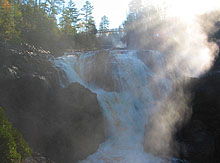Returning to the 148, continue towards Campbell’s Bay, which, again, is just off the highway. Settled by loggers and farmers, Campbell’s Bay is the county seat. It has an imposing courthouse (1917), which is open to visitors on weekdays.
Back on the 148, we continue in the direction of Fort Coulonge. The terrain here is flat with a fine view of the Ottawa River and Grand Calumet Island. About 8 kilometres along we come to Vinton. Known for its large stone Catholic Church, St. Elizabeth’s, Vinton was founded by Irish settlers in the late 1800s. Very little of this once thriving village remains, but the names in the cemetery (mostly Irish) tell the tale of Vinton’s past.
Our next stop is Fort Coulonge. The history of this town dates back to the 17th century, when the French established a fur-trading outpost here. In the 19th century, the settlement grew in importance, becoming a major timber centre. The town’s prosperity was due in large part to George Bryson, a Scottish entrepreneur who became the wealthiest lumber baron in the district. It was Bryson who built many of the town’s most imposing homes, some of which may still be seen today. He built large residences of cut stone for each of his children. One of them, Spruceholme (1875), is now an inn.
Bryson’s own home (which also served as headquarters for his logging empire), is located on the 148. Bryson House, as it is called, is an immense clapboard mansion with a cupola on the top and a long series of connected outbuildings. Built in 1854, the house is now home to the local library and museum. Across the river from Bryson House is the famous Marchand Bridge (1898), one of the longest covered bridges in Quebec. An impressive sight, the bridge is well worth strolling (or driving) across.

Sidetrip: A short distance past Fort Coulonge, and north of the highway on a winding country road, are the Chutes Coulonge. Once the centre of Bryson’s extensive logging operations, the falls are a splendid sight. They are now the focus of a park, with an interpretation centre, trails, and historic plaques. Chutes Coulonge Park is open daily from May to October.
Back on the 148 and west of Fort Coulonge, we arrive at Waltham. Waltham was once the western terminus of the old Pontiac Pacific Junction Railway, which linked Aylmer with the Pontiac. In recent years, the “PPJ” has been converted to a bicycle path, which is now a major tourist attraction for the region.
Just past Waltham, we cross onto L’Isle-aux-Allumettes. Leaving the 148 for the last time, we head west towards the village of Chapeau. Chapeau’s most noteworthy attraction is St-Alphonse-de-Liguori Catholic Church. Built to serve as a cathedral (for a diocese that never materialized), the church was endowed with a Casavant organ, splendid stained glass windows, and some fine sculpture. It is open daily to the public.
Thus concludes our trip from Aylmer to L’Isle-aux-Allumettes. There are, of course, many other sights to be discovered along the way. This tour is meant only as a guideline, and travellers may wish to spend more time exploring this beautiful region.